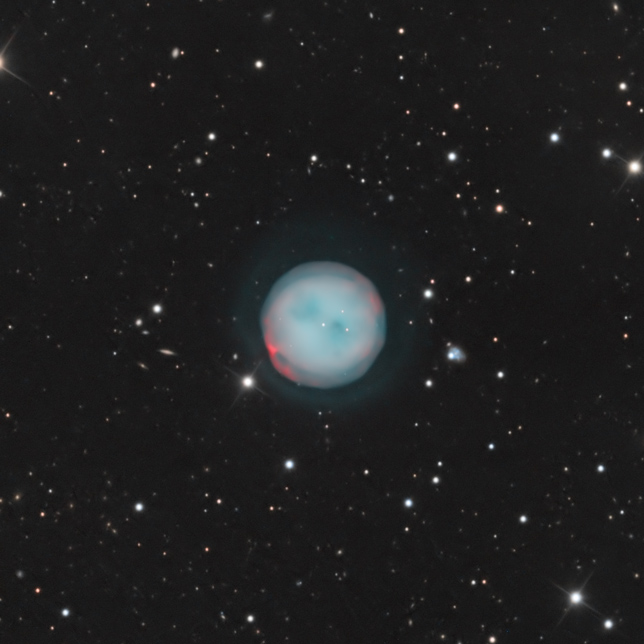

M97, the bright blue-green object at the center of the image, is a moderate-sized (about 3.4 arcminutes in diameter), fairly bright (magnitude 10 according to most sources) planetary nebula,
the type of nebula which it is generally thought our Sun will produce as nuclear fusion slows and then dies in its core, and it expels its outer layers of gas (the star itself ultimately shrinks to become a
"white dwarf"; the progenitor star, according to Wikipedia, now has 55–60% of our Sun's mass in a sphere with less than 1% of our Sun's diameter--it's really dense!, 41–148 times the brightness of our Sun, and an effective temperature of
123,000 K--compared to our Sun's 5800 K temperature). M97 is estimated to be anywhere from about 1300 light years from us, to over 10,000 light years from us; the most common numbers are around 2,000 or a
little more, which would make it a little less than one light years across. It is commonly known as the "Owl Nebula," because an early observer of the nebula drew it to resemble an owl (note the two "eyes"
inside the nebula).
The main color is a result of the strong emissions of doubly-ionized oxygen atoms (OIII); the red is from the emissions of hydrogen ions (hydrogen alpha). The faint outer shell seems to be entirely OIII, since it doesn't show up at all in the Ha images.
I always love how almost any view of the heavens will show so many background galaxies, and this is no exception. If you examine the highest-resolution version, you can see many tiny galaxies mixed in
among the stars (they're the ones that are either quite oblong or faint and blurry, so generally a galaxy). Of course, these are huge things, tens of thousands of light years across, with billions upon
billions of stars in each one, but they're so far away they barely show at all.
Copyright 2019 Mark de Regt